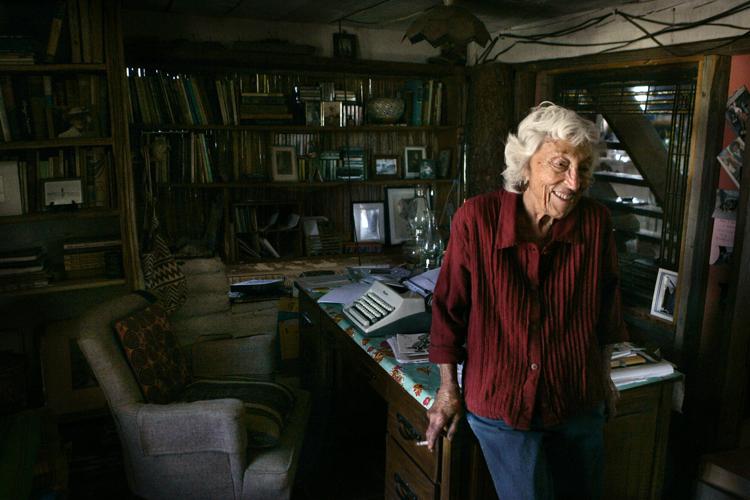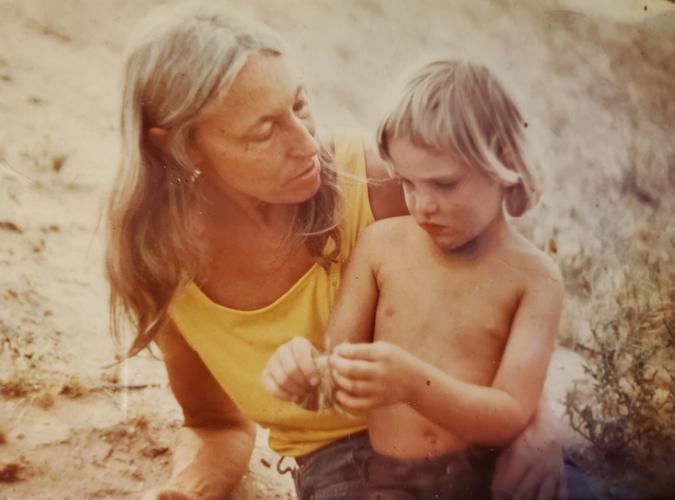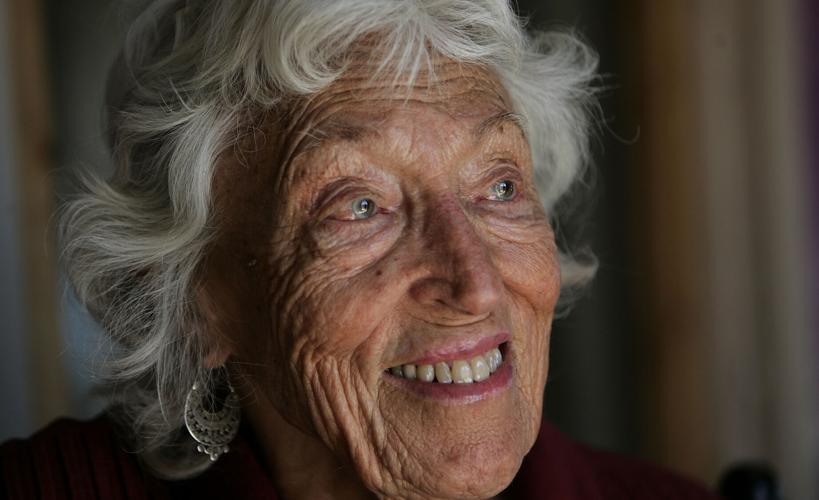For more than 40 years, author Byrd Baylor lived, ate, breathed, wrote about and celebrated the Southwest’s Native American, white and Latino cultures and its desert plants and wildlife.
In an influential novel, more than two dozen children’s books that also appealed to adults, and countless essays, Baylor chronicled the oft-uneasy but oft-warm relationships between Anglos and Native Americans and between humans and wildlife.
She was also a crusader: for protection of native wildlife, against government-sanctioned killings of predators in the name of protecting cattle, and for Mexican-based migrants. For the migrants, she provided food and water since the early 2000s in a camp at her Arivaca homestead, 50 miles southwest of Tucson.
Baylor died at age 97 on June 16, at the Tucson home of her grandson Jesse Stanley, of what Stanley described as “old age.” She was a stomach cancer survivor in her 80s, who quit chemotherapy halfway through the treatments because “she felt the chemo was going to kill her more than cancer did,” Stanley said.
Baylor was clearly a product of another generation, shunning computers for her literary efforts in favor of a yellow pad and a manual typewriter. She did much of her work in an adobe house on 50 acres in Arivaca, where she lived from the 1980s full and part time until moving to Tucson in the 2010s to live with grandson Stanley.
In Arivaca, she lived off the grid, in a home with dirt floors and marginal electricity, forcing her to read at night on a kerosene lamp, and to get water from a windmill-powered well.
“Byrd Baylor was tough, just as Tucson and Arizona are tough. Her writing reflects a critical independence that was sometimes harsh but never mean,” said David Laird, a former head University of Arizona librarian and a Southwest bookstore owner.
Laird got Baylor’s novel, “Yes Is Better Than No,” listed as one of 100 “Essential Books for the Centennial” in 2012 when Arizona observed 100 years of statehood.
“She exposed our city and state as it was and is, and we are all better for it,” Laird said last week in an email to the Star. “She was plain-spoken and tough and that was only leavened by the fact that she was funny.”
Despite that toughness, Baylor had the conscience of a saint and the heart of an angel, said Bill Broyles, a longtime Southwestern writer who said he knew her for 35 to 40 years.
“She was not afraid to battle the U.S. Fish and Wildlife Service and other federal agencies when they were shooting at coyotes or sanctioning the shooting,” Broyles recalled.
“But she’d also sit down, have lunch with them, and while they laughed and would tell jokes, she would tell them ‘why are you doing this, it’s not consistent with the law or policy and your mission — you are supposed to be taking care of wildlife.’”
Knew early she would be a writer
Born March 28, 1924, Baylor spent her early childhood living in and outside San Antonio, and other parts of Texas, before moving to Tucson at age 5 or 6.
Her father, George Baylor, worked on oil rigs in Texas. While in Tucson, he prospected for gold in Sonora and worked as a construction supervisor for the state highway department.
Her great-great-great uncle on her father’s side, Robert Emmett Bledsoe Baylor, was co-founder of Baylor University. A great-grandfather, John R. Baylor, was a Confederate officer in the 1860s, when he proclaimed himself the first governor of the Arizona Territory.
Byrd Baylor left little doubt from early childhood of her ambition to be a writer, her grandson recalled.
“She told me she wrote in a childhood diary, ‘I’m going to be a writer or president,’’ her grandson Stanley said.
She attended the University of Arizona for several years but never graduated. From 1951 to 1955, she worked as a reporter and arts writer for the now-defunct Tucson Daily Citizen, chronicling what was then a burgeoning arts scene that drew painters, musicians and other artists from around the U.S. to Tucson’s mild winters and then-laid-back desert lifestyle.
She wrote about people on the Tohono O’odham reservation. She wrote about poverty in Tucson. But when she started to write about a well-known Tucsonan who also happened to be a slumlord, “I was cut off absolutely. I was so innocent at the time,” Baylor told former Arizona Daily Star columnist Bonnie Henry in a 2009 interview.
George Rosenberg, former managing editor at the Citizen and a “fond admirer” of Baylor, told Henry, “Byrd was a wonderful, elegant writer. She was just too good for the trouble and culture of a newsroom. Obviously, her world was different.”
Childlike wonder charmed adults
She then pursued freelance writing. Her first piece, a short story about a romance set in Sonora, was published in Redbook magazine in 1957. Six years later came her first book, “Amigo,” about a young Mexican boy and a prairie dog who take to one another and form a friendship.
The idea for the book grew out of a story she had made up for her son, Tony, then 15, when he was much younger, Baylor told a Citizen interviewer back then.
“He had a great interest in nature, but he brought home so many things — snakes and Gila monsters and a prairie dog — that I was forced to encourage him to let wild things be wild and to be friendly with them in their natural habitat,” Baylor said.
Mark Bahti, owner of Bahti Indian Arts in Tucson and Santa Fe and a friend of Baylor’s for more than 50 years, noted that Baylor was involved back in the 1960s in founding the Tucson Indian Center.
Her later novel “Yes Is Better Than No” reflected her experiences with Native Americans in a “profound, insightful way,” he said.
Overall, Bahti said, “Nobody really knew how to categorize her work. They called them children’s books but they resonated with adults too.”
Many or most of the other books were written from the viewpoint of wonder and discovery when children see the world — a viewpoint that adults seem to lose, he said.
“Most people would say they are really beautiful, moving poetry rather than prose,” Bahti said. “Some of her books had quiet respect and honor woven into them. Others opened the door to discovery and, for adults, rediscovery of the natural world around us.
“Her voice was the voice of the desert and its people, of anybody, whether Tohono, Hispanic or Anglo, who truly lives in the desert — in the natural desert,” he said.
1977 novel still a classic
Published in 1977, “Yes is Better than No” remains in print today and is considered a Southwestern classic.
It told of an O’odham woman — the tribe was then known as the Papagos — who won a swimming pool in a lottery but whose family didn’t know what to do with it because the family lacked running water. Eventually, the pool was covered with a tarp and made into living quarters.
“It’s about a group of Tohono O’Odham who move into Tucson, and have to deal with Anglos with a totally different mindset. They learn it’s better to say yes than no,” said Bruce Dinges, a former Arizona Historical Society director of publications who supervised creation of the Arizona centennial 100-book list.
On its release, the novel got a mixed review from the Star, which praised it as enlightening to those who know nothing about a people who at the time lived close to downtown Tucson. But it also called the book “simple, too simple,” and said some characters were “a little too pat.”
In 2012, when Laird got the book on the Arizona centennial list, he recalled that one reviewer at the time even thought it was a racist look at American Indians.
Laird wrote, “It is, in fact, just the opposite — a clear-eyed viewing of the difficulties faced by Papagos (now renamed Tohono O’odham, by their own choice) in and around Tucson.”
Tohono O’odham Nation Chairman Ned Norris Jr. said Friday: “Byrd Baylor’s writing is infused with love for both the desert and for the people who call it home. Her work captures the warmth and complexity of Tohono O’odham families in a particular chapter of our history, one which she impacted through her support of the Tucson Indian Center. She will be greatly missed, but her legacy will continue delighting readers for generations to come.”
Works poured out for decades
Four of her books won Caldecott Medical awards during the 1970s from the American Library Association for the most distinguished picture books of those years aimed at children.
Baylor routinely cranked out books and essays well into the 1990s, and kept writing sporadically long afterward. Her last book, “The Table where Rich People Sit,” came out in 1998.
In the 1980s, she wrote well over a dozen essays for Tucson’s City Magazine, edited by the late writer Charles Bowden, dealing with everything from the attachment of south-siders to St. Jude (“the saint of desperate circumstances, hopeless cases, impossible desires”), to her run-ins with the feds over predator killing, to her never-ending home construction project in Arivaca.
One memorable essay appeared in the monthly Arivaca Connection newspaper, dealing with her incurable love for bad trucks.
“My favorite was a red, 1940-something Ford which was so beautiful that I overlooked the fact that it did not have a motor,” she wrote of a truck that she later had painted blue. “It sat in my driveway for three years, motionless.
“I highly recommend owning a truck without a motor because you have no unreasonable expectations, such as that it might run for three weeks without breaking down. You expect absolutely nothing of it except to sit there looking sky blue, and there is very little chance of it being disappointed.”
In the 2000s, Baylor became just about as well known for her willingness to harbor undocumented Mexican migrants. She first invited, then worked closely with, the group No More Deaths to operate the Byrd Camp on her Arivaca land.
No More Deaths’ Steve Johnston says the camp has run nonstop for 16 years and will continue to run with permission from Baylor’s grandson, Stanley.
In a tribute last year, Johnston called Baylor the group’s heart and soul. The group exists to memorialize migrants who die in the desert and to fight for a border policy that will better protect them.
“Byrd’s writing room is outdoors in a converted chicken coop and overlooks the Papalote Wash, a major migrant trail,” wrote Johnston, a longtime No More Deaths volunteer. “She has watched travelers put down their backpacks and take advantage of the tall swing she has hanging from a huge walnut tree in the middle of the wash.
“From her perch, Byrd has called out to an uncountable number of those passing through to offer water and food — in a word, hospitality.”
Baylor is survived by a son, Dennis Stanley, of Redondo Beach, California, two other grandchildren besides Jesse Stanley, and numerous great-grandchildren. Baylor was married and divorced twice.
Jesse Stanley said a memorial for Baylor will be held in October, with details coming later.








